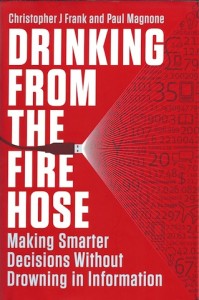The one-sentence summary
You can avoid drowning in data by asking seven simple questions.
WHAT THE BOOK SAYS 
- It is possible to make smarter decisions without drowning in information.
- Information is essential in making intelligent decisions, but more often than not it overwhelms us – it’s like drinking from a fire hose.
- Most business cultures these days worship numbers, but useless data saps morale.
- The Spray and Pray approach pervades many presentations – the presenter sprays as much data at the audience as possible, and prays that someone will spot something that’s relevant. A tight story (‘edited footage’) with decent discussion time is what’s needed.
- The knack to dealing with this and finding the most helpful nuggets is to ask the right questions at the right time.
- The authors explain seven questions that fall broadly into the categories of discovery, insight, and delivery (the sequence is not fixed):
1. What is the essential business question? (What is the one vital piece of information you need to move forward? IWIK stands for “I wish I knew…” – a sentence that needs to be completed to explain what research needs to reveal)
2. Where is your customer’s North Star? (Are you navel-gazing or truly listening to what customers really want? Use a Customer Impact Assessment to work out how plans will affect customers before you make them)
3. Should you believe the squiggly line? (Gain perspective by stepping further away from the data to avoid short-termism: context is king)
4. What surprised you? (Don’t regard numbers you can’t explain as outliers, and don’t just look at the numbers you expected to see – you need permission to think differently)
5. What does the lighthouse reveal? (Define the criteria that are relevant to your business and use them to guide, warn or serve as an example as to what will happen next – ignore irrelevant stuff and look for a new pattern)
6. Who are your swing voters? (Neutral, somewhat satisfied, customers offer the greatest opportunity for growth. Identify them and work out what will impress them most)
7. The three Ws: What? So what? Now what? (Find the data that really matters, work out what it means, recommend what to do, and act on it)
WHAT’S GOOD ABOUT IT
- Businesses need to concentrate on the difference between things that are complicated as opposed to complex. Complicated things are going to the moon or performing hip surgery – they are difficult, but you can follow a process. Complex things are raising a child or running a healthcare system – these require a set of principles, but cannot be predicted in a linear way.
- The Hype Cycle begins with a Technology Trigger, creates a Peak of Inflated Expectations, followed by a Trough of Disillusionment, a Slope of Enlightenment, and a Plateau of Productivity.
- Do you have the time to be surprised? Helpful data discoveries do not happen in a rush – they need time to be found and deemed worthy of investigation.
- Insights are borne out of rapid iteration – continually reassess your position to learn and re-learn, generating course corrections as you go.
WHAT YOU HAVE TO WATCH
- If you are not data-savvy you might want to skip the detail and just grab the method.
